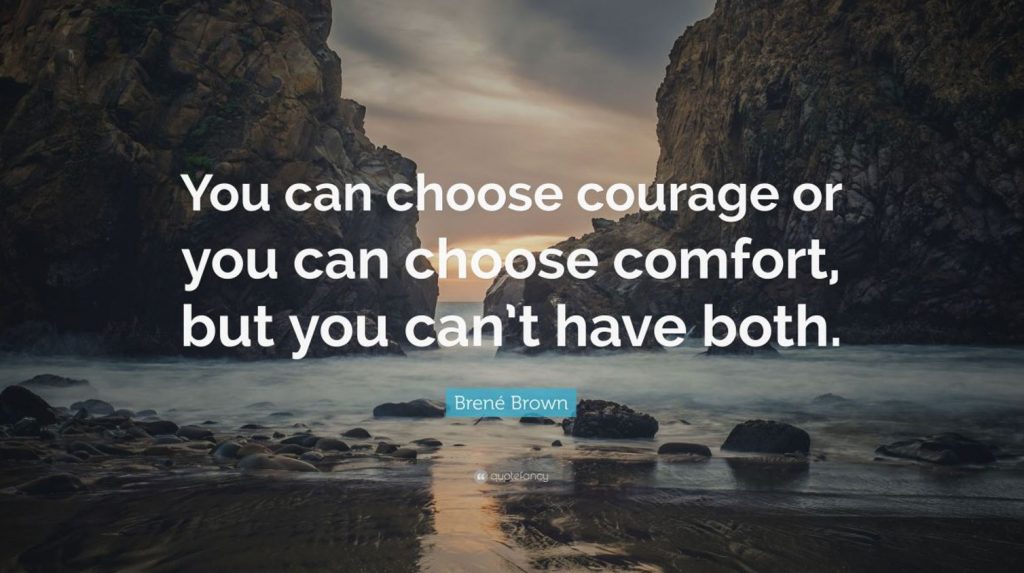Every one of us has a Comfort Zone where we feel safe and reasonably secure. People who live within their Comfort Zone like predictability and value feeling safe and in control. The difficulty with spending too much of life within our Comfort Zones is that life can become repetitive and boring and we do not experience any personal or professional growth or development. Courageous Leaders are aware that just outside the Comfort Zone lies a region known as our ‘Growth Zone’. When we lead, or participate in tasks that are just outside our Comfort Zone, we experience personal and/or professional growth and development. As humans, we are built for personal growth – it is hardwired into our DNA and so when we challenge ourselves to go outside our comfort zone we can experience the power and exhilaration of reaching and expressing more of our innate potential.

The Comfort Zone / The Growth Zone © HeiFetz, R
The expression “There is no Growth in the Comfort Zone and no Comfort in the Growth Zone” holds a lot of truth. Even though we can be aware of the growth opportunities that lie just outside our Comfort Zones, going outside of our Comfort Zones can feel scary and so to overcome this fear and to experience the growth, we need to embrace our vulnerability. Within vulnerability lies the power to overcome our resistance to travelling outside of our Comfort Zone. Vulnerability is the courage to put our desire for personal and professional growth as a person and as a Leader beyond the fear of travelling beyond our Comfort Zone.
Research over the past decade shows that organisations are seeking more creative and innovative business solutions in cultures of higher trust, more empathy, higher psychological safety, less drama, and more honest and robust conversations. Yet, in reality what we see are Leaders avoiding the tough conversations – Leaders dancing around the truth – Leaders not holding each other accountable – Leaders who struggle to embrace and implement change programs and Leaders who really struggle to offer or receive necessary feedback. In summary we see leaders lacking the necessary courage to be truly effective. The consequences of this lack of courage are a significant underperformance on Key Business Indicators. The only way to be truly effective and courageous Leaders is to be willing to step outside of our comfort zones and embrace our vulnerability. Sustainable high performance and effective leadership cannot happen from within our Comfort Zones.
THE MAN IN THE ARENA
– Excerpt from the speech “Citizenship In A Republic” by Theodore Roosevelt
It is not the critic who counts; not the man who points out how the strong man stumbles, or where the doer of deeds could have done them better. The credit belongs to the man who is actually in the arena, whose face is marred by dust and sweat and blood; who strives valiantly; who errs, who comes short again and again, because there is no effort without error and shortcoming; but who does actually strive to do the deeds; who knows great enthusiasms, the great devotions; who spends himself in a worthy cause; who at the best knows in the end the triumph of high achievement, and who at the worst, if he fails, at least fails while daring greatly…
Organizations are changing so rapidly that they need to have every person fully engaged in a wholehearted way – fully in the arena – not passively participating from the sidelines. Fear, excessive deliberation and general inertia are what keep us on the sidelines. Accepting and acknowledging our vulnerabilities and to take action in the presence of our vulnerabilities is the way to show up fully in the arena, fully engaged in a wholehearted way.
In her book entitled ‘Daring Greatly’, Brene Brown uses twelve years of research into vulnerability and its link to courage and taking positive action. When we shut ourselves off from vulnerability, we distance ourselves from the experience of wholehearted and courageous leadership and from Leading with Humility. We avoid feeling uncomfortable because of the fear of disconnection – of not being enough. However, the truth is that nothing is as uncomfortable, dangerous or disheartening as standing on the outside looking in and wondering what it would be like if we had the courage to step into the arena – whether that means speaking out against the consensus of your more senior Leaders; taking a bold and creating step into the unknown or having a high stakes Courageous Conversation. Developing awareness of our patterns of behavior when we are denying or hiding our vulnerability in order to protect ourselves helps us to become more aware of the impact of vulnerability on us as Leaders and calls on our personal courage to take action.
Working with openness to our vulnerability is the key to daring greatly and to being the best that we can be. Fear of being shamed leads to risk aversion and risk aversion kills innovation. Unwillingness to being vulnerable keeps us small and afraid. We need to know and experience the discomfort and value of being vulnerable so that we can step through it and beyond it into our most authentic best. Embracing vulnerability as Leader will support you to create thigh performance cultures where team members will volunteer their highest contribution because they will feel seen, heard, validated and respected.
When we are being authentic and wholehearted we are being ‘who we really are’ and not ‘who others believe that we should be’ and from that place we are courageous risk takers and positive role models. We are True Authentic Leaders!

